check engine light YAMAHA XVS650 2001 Owners Manual
[x] Cancel search | Manufacturer: YAMAHA, Model Year: 2001, Model line: XVS650, Model: YAMAHA XVS650 2001Pages: 106, PDF Size: 16.06 MB
Page 19 of 106
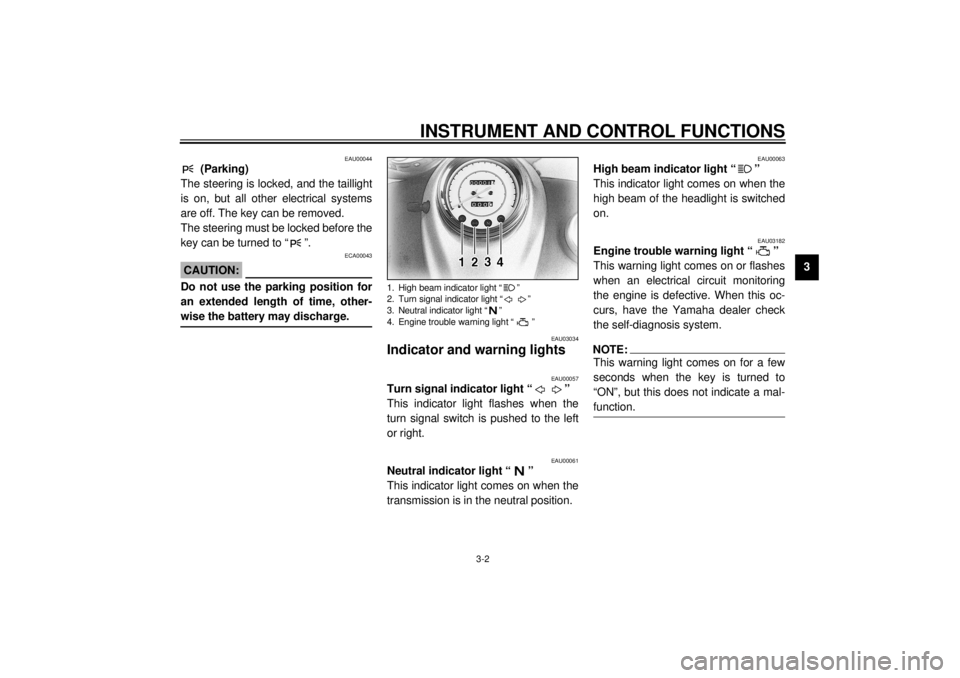
INSTRUMENT AND CONTROL FUNCTIONS
3-2
3
EAU00044
(Parking)
The steering is locked, and the taillight
is on, but all other electrical systems
are off. The key can be removed.
The steering must be locked before the
key can be turned to “ ”.
ECA00043
CAUTION:@ Do not use the parking position for
an extended length of time, other-
wise the battery may discharge. @
EAU03034
Indicator and warning lights
EAU00057
Turn signal indicator light “ ”
This indicator light flashes when the
turn signal switch is pushed to the left
or right.
EAU00061
Neutral indicator light “ ”
This indicator light comes on when the
transmission is in the neutral position.
EAU00063
High beam indicator light “ ”
This indicator light comes on when the
high beam of the headlight is switched
on.
EAU03182
Engine trouble warning light “ ”
This warning light comes on or flashes
when an electrical circuit monitoring
the engine is defective. When this oc-
curs, have the Yamaha dealer check
the self-diagnosis system.NOTE:@ This warning light comes on for a few
seconds when the key is turned to
“ON”, but this does not indicate a mal-
function. @
1. High beam indicator light “ ”
2. Turn signal indicator light “ ”
3. Neutral indicator light “ ”
4. Engine trouble warning light “ ”
E_5bn.book Page 2 Wednesday, October 4, 2000 7:51 PM
Page 40 of 106
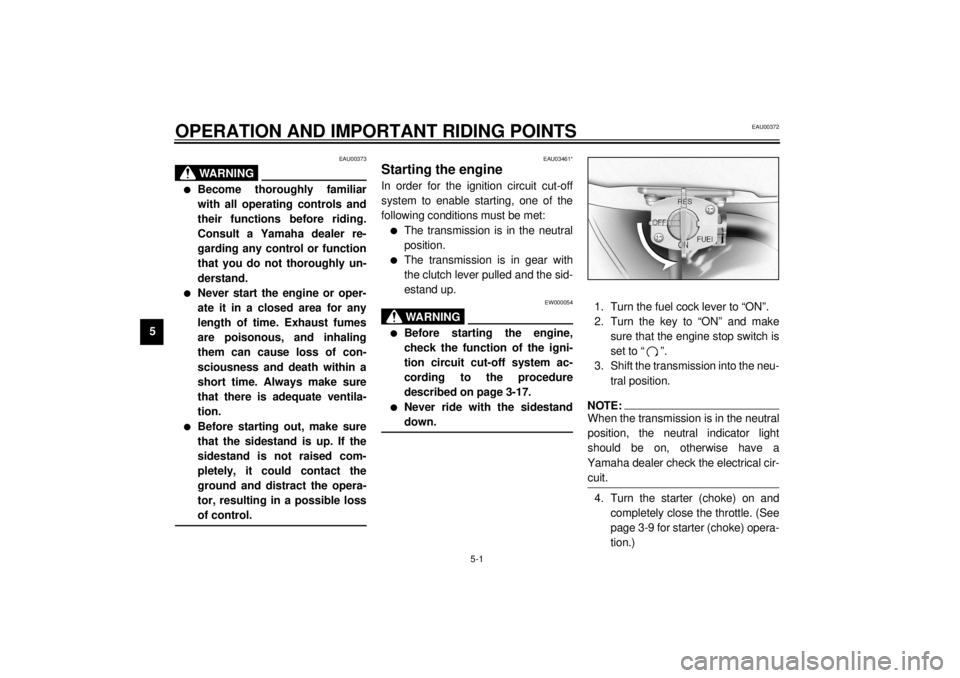
5-1
5
EAU00372
5-OPERATION AND IMPORTANT RIDING POINTS
EAU00373
WARNING
@ l
Become thoroughly familiar
with all operating controls and
their functions before riding.
Consult a Yamaha dealer re-
garding any control or function
that you do not thoroughly un-
derstand.
l
Never start the engine or oper-
ate it in a closed area for any
length of time. Exhaust fumes
are poisonous, and inhaling
them can cause loss of con-
sciousness and death within a
short time. Always make sure
that there is adequate ventila-
tion.
l
Before starting out, make sure
that the sidestand is up. If the
sidestand is not raised com-
pletely, it could contact the
ground and distract the opera-
tor, resulting in a possible loss
of control.
@
EAU03461*
Starting the engine In order for the ignition circuit cut-off
system to enable starting, one of the
following conditions must be met:l
The transmission is in the neutral
position.
l
The transmission is in gear with
the clutch lever pulled and the sid-
estand up.
EW000054
WARNING
@ l
Before starting the engine,
check the function of the igni-
tion circuit cut-off system ac-
cording to the procedure
described on page 3-17.
l
Never ride with the sidestand
down.
@
1. Turn the fuel cock lever to “ON”.
2. Turn the key to “ON” and make
sure that the engine stop switch is
set to “ ”.
3. Shift the transmission into the neu-
tral position.NOTE:@ When the transmission is in the neutral
position, the neutral indicator light
should be on, otherwise have a
Yamaha dealer check the electrical cir-
cuit. @4. Turn the starter (choke) on and
completely close the throttle. (See
page 3-9 for starter (choke) opera-
tion.)
E_5bn.book Page 1 Wednesday, October 4, 2000 7:51 PM
Page 41 of 106
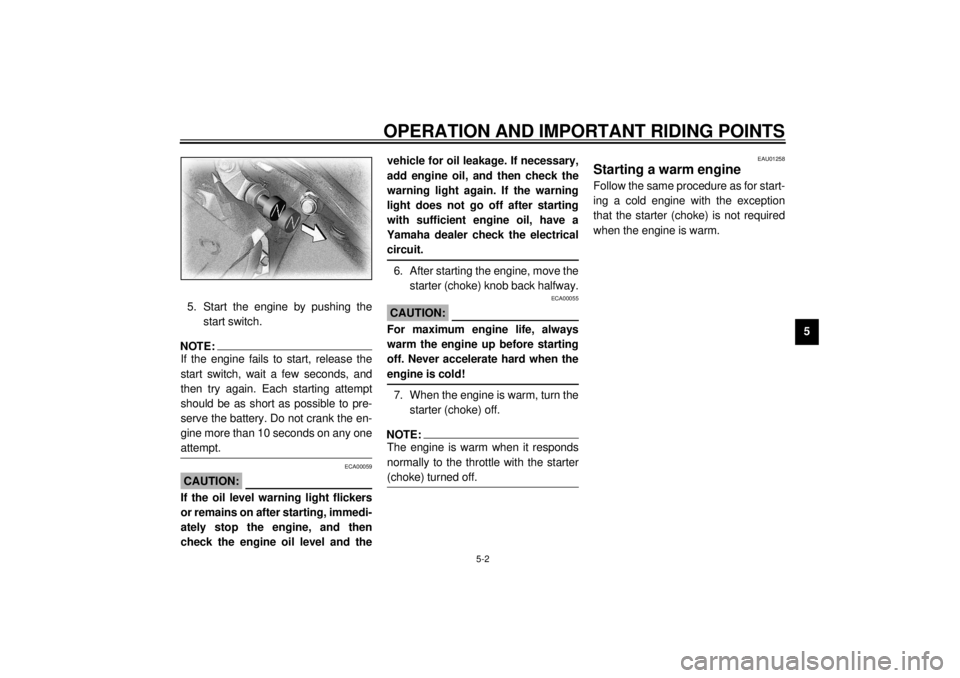
OPERATION AND IMPORTANT RIDING POINTS
5-2
5 5. Start the engine by pushing the
start switch.
NOTE:@ If the engine fails to start, release the
start switch, wait a few seconds, and
then try again. Each starting attempt
should be as short as possible to pre-
serve the battery. Do not crank the en-
gine more than 10 seconds on any one
attempt. @
ECA00059
CAUTION:@ If the oil level warning light flickers
or remains on after starting, immedi-
ately stop the engine, and then
check the engine oil level and thevehicle for oil leakage. If necessary,
add engine oil, and then check the
warning light again. If the warning
light does not go off after starting
with sufficient engine oil, have a
Yamaha dealer check the electrical
circuit.
@6. After starting the engine, move the
starter (choke) knob back halfway.
ECA00055
CAUTION:@ For maximum engine life, always
warm the engine up before starting
off. Never accelerate hard when the
engine is cold! @7. When the engine is warm, turn the
starter (choke) off.NOTE:@ The engine is warm when it responds
normally to the throttle with the starter
(choke) turned off. @
EAU01258
Starting a warm engine Follow the same procedure as for start-
ing a cold engine with the exception
that the starter (choke) is not required
when the engine is warm.
E_5bn.book Page 2 Wednesday, October 4, 2000 7:51 PM
Page 43 of 106
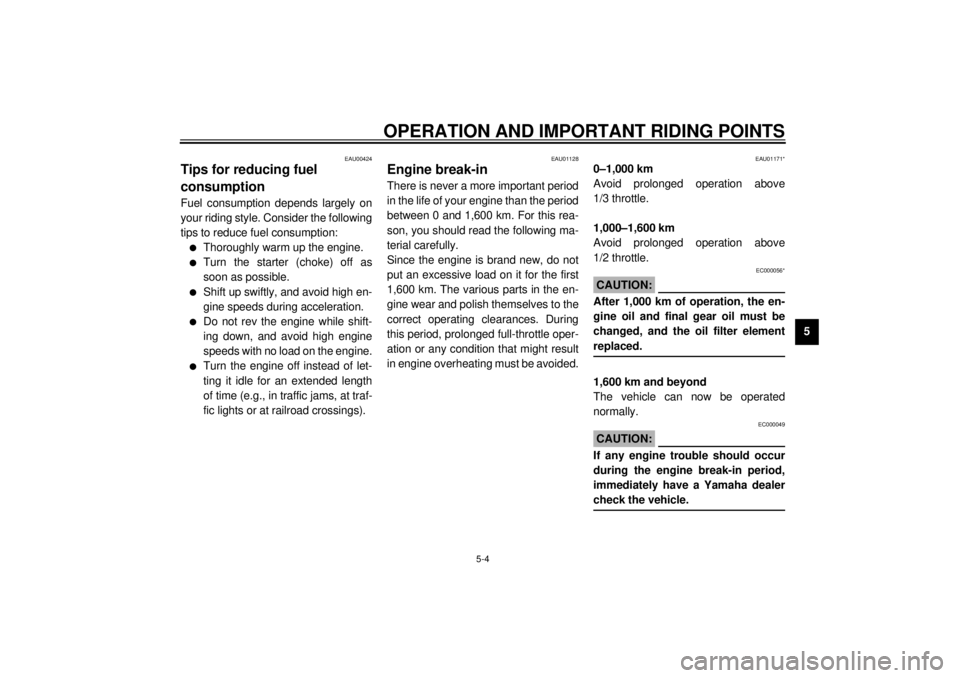
OPERATION AND IMPORTANT RIDING POINTS
5-4
5
EAU00424
Tips for reducing fuel
consumption Fuel consumption depends largely on
your riding style. Consider the following
tips to reduce fuel consumption:l
Thoroughly warm up the engine.
l
Turn the starter (choke) off as
soon as possible.
l
Shift up swiftly, and avoid high en-
gine speeds during acceleration.
l
Do not rev the engine while shift-
ing down, and avoid high engine
speeds with no load on the engine.
l
Turn the engine off instead of let-
ting it idle for an extended length
of time (e.g., in traffic jams, at traf-
fic lights or at railroad crossings).
EAU01128
Engine break-in There is never a more important period
in the life of your engine than the period
between 0 and 1,600 km. For this rea-
son, you should read the following ma-
terial carefully.
Since the engine is brand new, do not
put an excessive load on it for the first
1,600 km. The various parts in the en-
gine wear and polish themselves to the
correct operating clearances. During
this period, prolonged full-throttle oper-
ation or any condition that might result
in engine overheating must be avoided.
EAU01171*
0–1,000 km
Avoid prolonged operation above
1/3 throttle.
1,000–1,600 km
Avoid prolonged operation above
1/2 throttle.
EC000056*
CAUTION:@ After 1,000 km of operation, the en-
gine oil and final gear oil must be
changed, and the oil filter element
replaced. @1,600 km and beyond
The vehicle can now be operated
normally.
EC000049
CAUTION:@ If any engine trouble should occur
during the engine break-in period,
immediately have a Yamaha dealer
check the vehicle. @
E_5bn.book Page 4 Wednesday, October 4, 2000 7:51 PM
Page 45 of 106
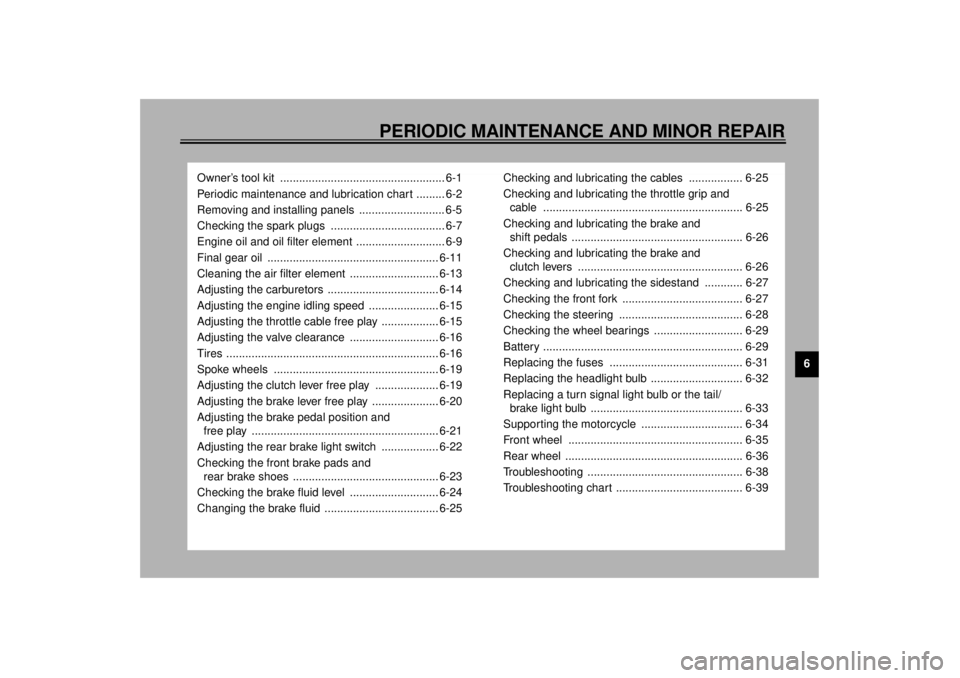
6
PERIODIC MAINTENANCE AND MINOR REPAIR
Owner’s tool kit .................................................... 6-1
Periodic maintenance and lubrication chart ......... 6-2
Removing and installing panels ........................... 6-5
Checking the spark plugs .................................... 6-7
Engine oil and oil filter element ............................ 6-9
Final gear oil ...................................................... 6-11
Cleaning the air filter element ............................ 6-13
Adjusting the carburetors ................................... 6-14
Adjusting the engine idling speed ...................... 6-15
Adjusting the throttle cable free play .................. 6-15
Adjusting the valve clearance ............................ 6-16
Tires ................................................................... 6-16
Spoke wheels .................................................... 6-19
Adjusting the clutch lever free play .................... 6-19
Adjusting the brake lever free play ..................... 6-20
Adjusting the brake pedal position and
free play ........................................................... 6-21
Adjusting the rear brake light switch .................. 6-22
Checking the front brake pads and
rear brake shoes .............................................. 6-23
Checking the brake fluid level ............................ 6-24
Changing the brake fluid .................................... 6-25Checking and lubricating the cables ................. 6-25
Checking and lubricating the throttle grip and
cable ............................................................... 6-25
Checking and lubricating the brake and
shift pedals ...................................................... 6-26
Checking and lubricating the brake and
clutch levers .................................................... 6-26
Checking and lubricating the sidestand ............ 6-27
Checking the front fork ...................................... 6-27
Checking the steering ....................................... 6-28
Checking the wheel bearings ............................ 6-29
Battery ............................................................... 6-29
Replacing the fuses .......................................... 6-31
Replacing the headlight bulb ............................. 6-32
Replacing a turn signal light bulb or the tail/
brake light bulb ................................................ 6-33
Supporting the motorcycle ................................ 6-34
Front wheel ....................................................... 6-35
Rear wheel ........................................................ 6-36
Troubleshooting ................................................. 6-38
Troubleshooting chart ........................................ 6-39
E_5bn.book Page 1 Wednesday, October 4, 2000 7:51 PM
Page 52 of 106

PERIODIC MAINTENANCE AND MINOR REPAIR
6-7
6
EAU03329
Checking the spark plugs The spark plugs are important engine
components, which are easy to check.
Since heat and deposits will cause any
spark plug to slowly erode, the spark
plugs should be removed and checked
in accordance with the periodic mainte-
nance and lubrication chart. In addition,
the condition of the spark plugs can re-
veal the condition of the engine.To remove a spark plug
1. Remove the spark plug cap.
2. Remove the spark plug as shown,
with the spark plug wrench includ-
ed in the owner’s tool kit.
To check the spark plugs
1. Check that the porcelain insulator
around the center electrode on
each spark plug is a medium-to-
light tan (the ideal color when the
motorcycle is ridden normally).
2. Check that all spark plugs installed
in the engine have the same color.
NOTE:@ If any spark plug shows a distinctly dif-
ferent color, the engine could be defec-
tive. Do not attempt to diagnose such
problems yourself. Instead, have a
Yamaha dealer check the motorcycle. @3. Check each spark plug for elec-
trode erosion and excessive car-
bon or other deposits, and replace
it if necessary.
1. Spark plug cap
1. Spark plug wrench
Specified spark plug:
DPR7EA-9 (NGK) or
X22EPR-U9 (DENSO)
E_5bn.book Page 7 Wednesday, October 4, 2000 7:51 PM
Page 54 of 106
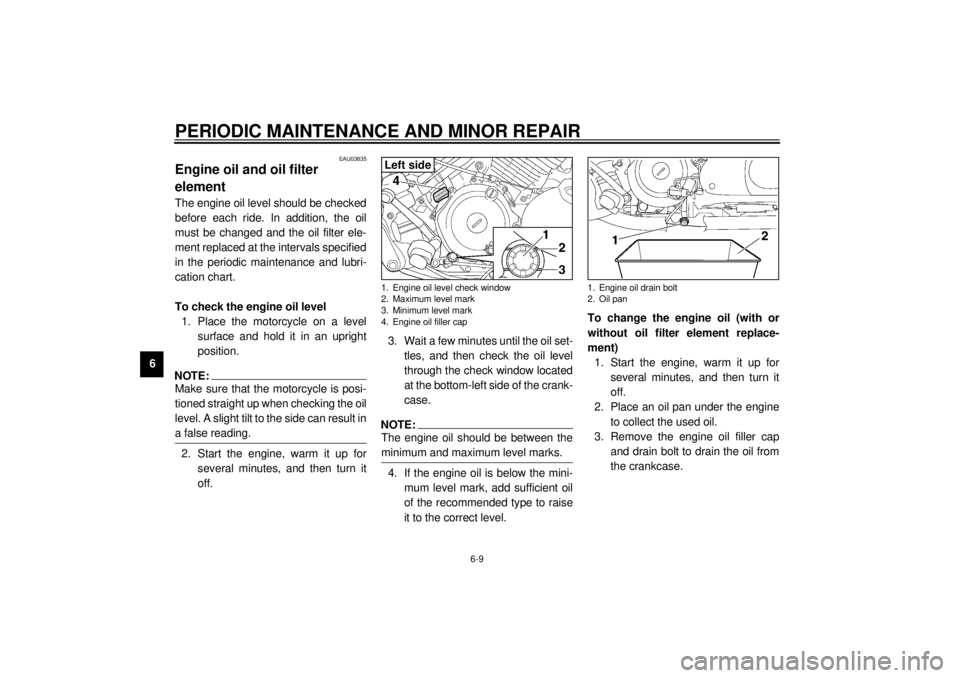
PERIODIC MAINTENANCE AND MINOR REPAIR
6-9
6
EAU03835
Engine oil and oil filter
element The engine oil level should be checked
before each ride. In addition, the oil
must be changed and the oil filter ele-
ment replaced at the intervals specified
in the periodic maintenance and lubri-
cation chart.
To check the engine oil level
1. Place the motorcycle on a level
surface and hold it in an upright
position.NOTE:_ Make sure that the motorcycle is posi-
tioned straight up when checking the oil
level. A slight tilt to the side can result in
a false reading. _2. Start the engine, warm it up for
several minutes, and then turn it
off.3. Wait a few minutes until the oil set-
tles, and then check the oil level
through the check window located
at the bottom-left side of the crank-
case.
NOTE:_ The engine oil should be between the
minimum and maximum level marks. _4. If the engine oil is below the mini-
mum level mark, add sufficient oil
of the recommended type to raise
it to the correct level.To change the engine oil (with or
without oil filter element replace-
ment)
1. Start the engine, warm it up for
several minutes, and then turn it
off.
2. Place an oil pan under the engine
to collect the used oil.
3. Remove the engine oil filler cap
and drain bolt to drain the oil from
the crankcase.1. Engine oil level check window
2. Maximum level mark
3. Minimum level mark
4. Engine oil filler capLeft side
1. Engine oil drain bolt
2. Oil pan
E_5bn.book Page 9 Wednesday, October 4, 2000 7:51 PM
Page 57 of 106
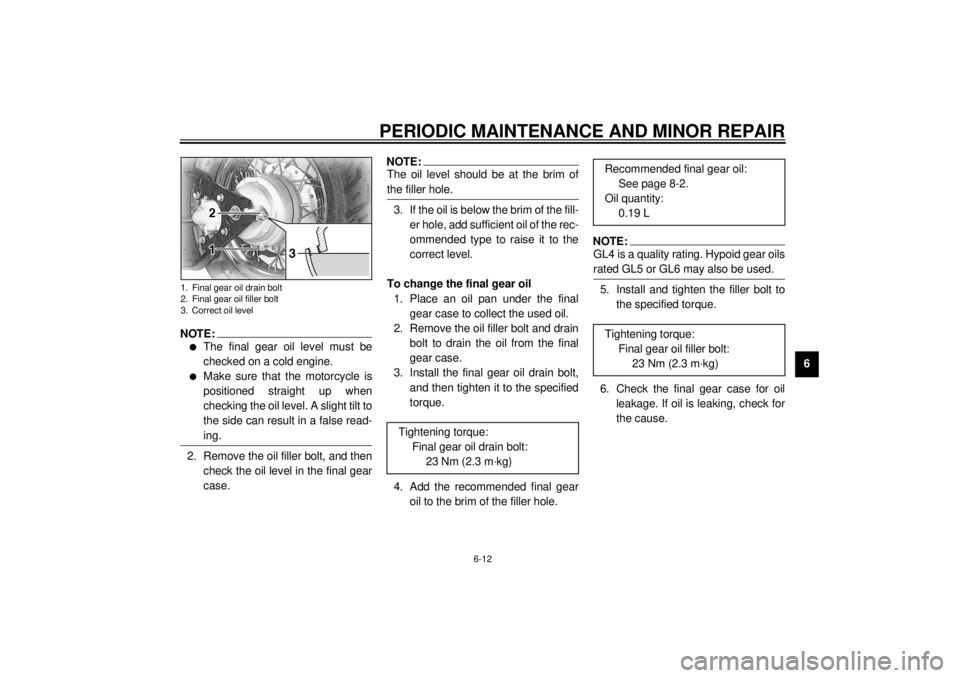
PERIODIC MAINTENANCE AND MINOR REPAIR
6-12
6
NOTE:@ l
The final gear oil level must be
checked on a cold engine.
l
Make sure that the motorcycle is
positioned straight up when
checking the oil level. A slight tilt to
the side can result in a false read-
ing.
@2. Remove the oil filler bolt, and then
check the oil level in the final gear
case.
NOTE:@ The oil level should be at the brim of
the filler hole. @3. If the oil is below the brim of the fill-
er hole, add sufficient oil of the rec-
ommended type to raise it to the
correct level.
To change the final gear oil
1. Place an oil pan under the final
gear case to collect the used oil.
2. Remove the oil filler bolt and drain
bolt to drain the oil from the final
gear case.
3. Install the final gear oil drain bolt,
and then tighten it to the specified
torque.
4. Add the recommended final gear
oil to the brim of the filler hole.
NOTE:@ GL4 is a quality rating. Hypoid gear oils
rated GL5 or GL6 may also be used. @5. Install and tighten the filler bolt to
the specified torque.
6. Check the final gear case for oil
leakage. If oil is leaking, check for
the cause.
1. Final gear oil drain bolt
2. Final gear oil filler bolt
3. Correct oil level
Tightening torque:
Final gear oil drain bolt:
23 Nm (2.3 m·kg)
Recommended final gear oil:
See page 8-2.
Oil quantity:
0.19 L
Tightening torque:
Final gear oil filler bolt:
23 Nm (2.3 m·kg)
E_5bn.book Page 12 Wednesday, October 4, 2000 7:51 PM
Page 102 of 106

10-INDEXAAir filter element, cleaning ...................... 6-13
Anti-theft alarm ........................................3-3BBattery ................................................... 6-29
Brake and clutch levers, checking
and lubricating ..................................... 6-26
Brake and shift pedals, checking
and lubricating ..................................... 6-26
Brake fluid, changing ............................. 6-25
Brake fluid level, checking...................... 6-24
Brake lever...............................................3-6
Brake lever free play, adjusting .............. 6-20
Brake light switch (rear), adjusting ......... 6-22
Brake pads and shoes, checking ........... 6-23
Brake pedal..............................................3-6
Brake pedal position and free play,
adjusting .............................................. 6-21CCables, checking and lubricating............ 6-25
Carburetors, adjusting............................ 6-14
Care.........................................................7-1
Clutch lever ..............................................3-5
Clutch lever free play, adjusting ............. 6-19
Conversion table ......................................8-6DDimmer switch .........................................3-4EEngine break-in........................................5-4
Engine oil and oil filter element.................6-9
Engine stop switch ...................................3-4
Engine trouble warning light .................... 3-2FFinal gear oil .......................................... 6-11
Front fork, checking ............................... 6-27
Fuel ......................................................... 3-7
Fuel cock ................................................. 3-8
Fuel consumption, tips for reducing ......... 5-4
Fuel tank cap ........................................... 3-7
Fuses, replacing .................................... 6-31HHandlebar switches ................................. 3-3
Headlight bulb, replacing ....................... 6-32
Helmet holder ........................................ 3-12
High beam indicator light ......................... 3-2
Horn switch ............................................. 3-4IIdentification numbers ............................. 9-1
Idling speed, adjusting ........................... 6-15
Ignition circuit cut-off system.................. 3-16
Indicator and warning lights ..................... 3-2KKey identification number ........................ 9-1LLight switch.............................................. 3-4
Luggage strap holders ........................... 3-15MMain switch/steering lock ......................... 3-1
Model label .............................................. 9-2
NNeutral indicator light ...............................3-2PPanels, removing and installing ................6-5
Parking.....................................................5-5
Part locations ...........................................2-1
Pass switch ..............................................3-4
Periodic maintenance and
lubrication chart .....................................6-2
Pre-operation check list ............................4-1SSafety information ....................................1-1
Seats (XVS650) .....................................3-10
Passenger seat.................................3-10
Rider seat .........................................3-10
Seats (XVS650A) ...................................3-11
Passenger seat.................................3-11
Rider seat .........................................3-11
Shifting .....................................................5-3
Shift pedal (XVS650)................................3-5
Shift pedal (XVS650A) .............................3-5
Shock absorber assembly, adjusting ......3-14
Sidestand ...............................................3-15
Sidestand, checking and lubricating .......6-27
Spark plugs, checking ..............................6-7
Specifications ...........................................8-1
Speedometer unit.....................................3-3
Starter (choke) knob.................................3-9
Starting a warm engine ............................5-2
Starting the engine ...................................5-1
Start switch ..............................................3-4
Steering, checking..................................6-28
E_5bn.book Page 1 Wednesday, October 4, 2000 7:51 PM